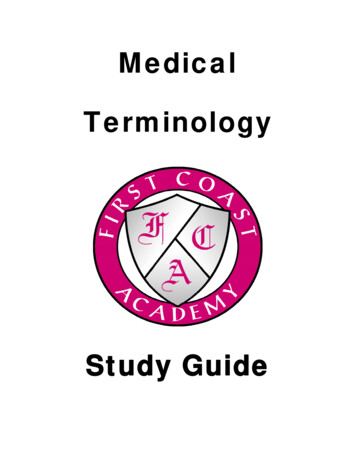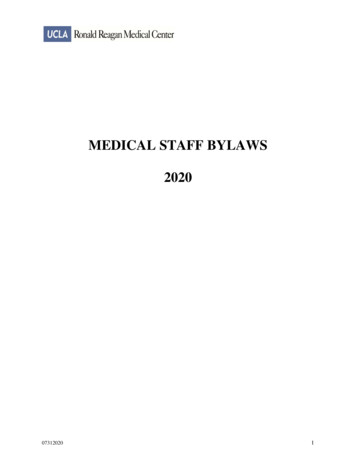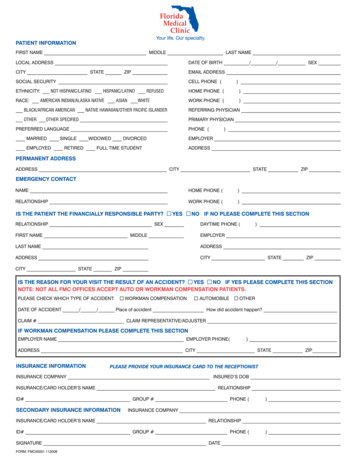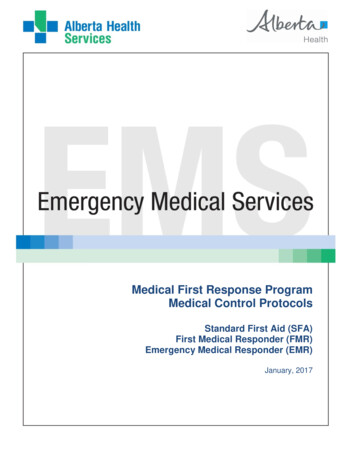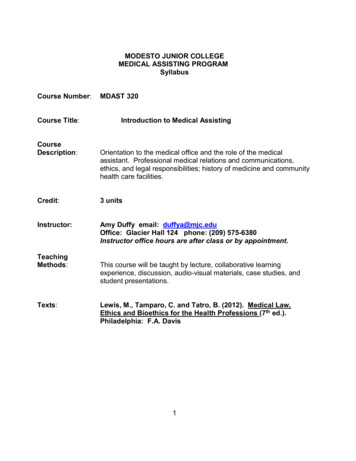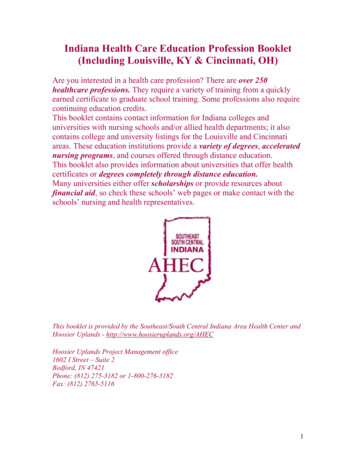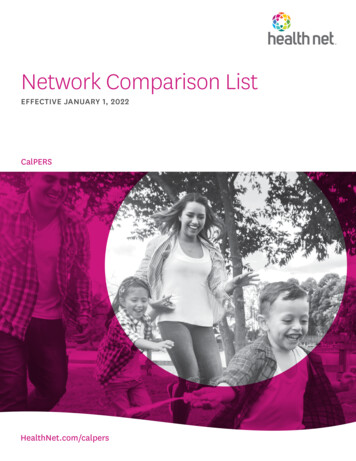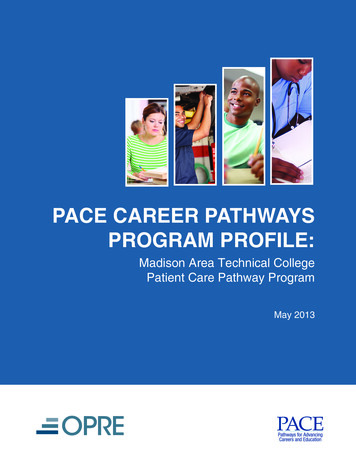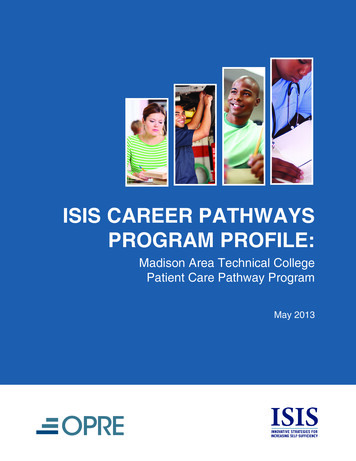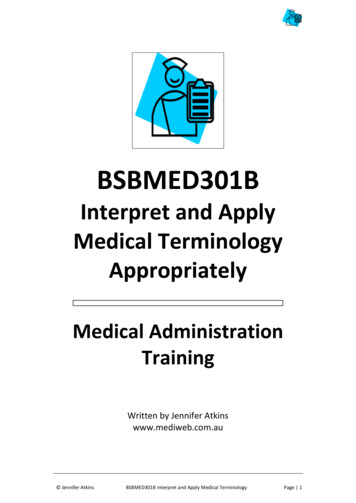
Transcription
BSBMED301BInterpret and ApplyMedical TerminologyAppropriatelyMedical AdministrationTrainingWritten by Jennifer Atkinswww.mediweb.com.au Jennifer AtkinsBSBMED301B Interpret and Apply Medical TerminologyPage 1
CopyrightCopyright Jennifer Atkins 2013.2 2009 Version 1This training manual is copyright under the Copyright Act 1968.Any third party copyright material included in this publication is attributed.Jennifer Atkins asserts her ownership of the Intellectual Property contained in thistraining manual. All rights are reserved. No part of this publication may bereproduced, transmitted, transcribed, stored in a retrieval system, utilised,distributed, or translated into any other language in whole or in part, in any form orby any means, by any other party whether it be electronic, manual, photocopying,recording, or otherwise.Copying without authorisation is illegal.DisclaimerEvery attempt has been made to ensure this workbook is free from errors oromissions. However, as an educational resource, all effort should be made toensure you seek professional advice before relying on any statement or factcontained herein. Material in this workbook is current at the time of writing.Jennifer Atkins Medical Administration Trainingwww.mediweb.com.au Jennifer AtkinsBSBMED301B Interpret and Apply Medical TerminologyPage 2
Table of ContentsRESOURCES: HELPFUL WEBSITES . 7BSBMED301B: INTERPRET AND APPLY MEDICAL TERMINOLOGY APPROPRIATELY. 9INTRODUCTION . 13WHAT IS MEDICAL TERMINOLOGY?14HOW IS MEDICAL TERMINOLOGY COMMUNICATED?15POLICIES AND PROCEDURES16SPECIALIST AREAS OF MEDICINE21CHECKLISTS23LEARNING MEDICAL TERMINOLOGY . 27ROOT WORD28COMBINING VOWEL29COMBINING FORM29PREFIX30SUFFIX30RULES WHEN JOINING MEDICAL TERMS TOGETHER32LITERAL MEANING OF MEDICAL TERMS40SEEK CLARIFICATION41DICTIONARY MEANING VERSUS LITERAL MEANING42AUSTRALIAN VERSUS AMERICAN SPELLING44SINGULAR AND PLURAL WORDS46PRONUNCIATION49MEDICAL TERMINOLOGY ACTIVITIES52MEDICAL ABBREVIATIONS. 61MEDICAL ABBREVIATIONS WRITTEN ON SCRIPTS62LIST OF COMMON MEDICAL ABBREVIATIONS66SYMBOLS68SYSTEMS OF THE BODY . 77ELEVEN MAIN SYSTEMS OF THE HUMAN BODY77ANATOMICAL PLANES AND POSITIONS . 85PLANES OF THE BODY86BODY CAVITIES87 Jennifer AtkinsBSBMED301B Interpret and Apply Medical TerminologyPage 3
DIRECTION AND LOCATION88LIST OF TERMS FOR POSITION AND DIRECTION90MOVEMENT OF JOINTS91ABDOMINOPELVIC QUADRANTS AND REGIONS93MEDICAL TERMINOLOGY ACTIVITIES96INTEGUMENTARY SYSTEM . 103INTERESTING FACTS ON THE INTEGUMENTARY SYSTEM104THE LAYERS OF THE SKIN105FUNCTIONS OF THE SKIN105SKIN COLOUR106MEDICAL TERMINOLOGY ACTIVITIES113GLOSSARY OF INTEGUMENTARY TERMS124SKELETAL SYSTEM . 127INTERESTING FACTS ON THE SKELETAL SYSTEM128FUNCTIONS OF THE SKELETON129TYPES OF FRACTURES130THE FIVE SECTIONS OF THE SPINE133MEDICAL TERMINOLOGY ACTIVITIES136NAMES OF SKELETAL BONES149GLOSSARY OF SKELETAL TERMS151MUSCULAR SYSTEM . 155INTERESTING FACTS ON THE MUSCULAR SYSTEM156HOW MUSCLES ARE NAMED157MAJOR MUSCLES OF THE BODY157MEDICAL TERMINOLOGY ACTIVITIES161NAMES OF MUSCLES173GLOSSARY OF MUSCULAR TERMS175DIGESTIVE SYSTEM. 179INTERESTING FACTS ON THE DIGESTIVE SYSTEM180FUNCTIONS OF THE DIGESTIVE ORGANS182PATIENT INFORMATION SHEET185MEDICAL TERMINOLOGY ACTIVITIES192GLOSSARY OF DIGESTIVE TERMS202 Jennifer AtkinsBSBMED301B Interpret and Apply Medical TerminologyPage 4
CARDIOVASCULAR SYSTEM . 207INTERESTING FACTS ON THE CARDIOVASCULAR SYSTEM208FUNCTIONS OF THE CARDIOVASCULAR ORGANS209ELECTROCARDIOGRAM (ECG)212HIGH BLOOD PRESSURE215MEDICAL TERMINOLOGY ACTIVITIES220GLOSSARY OF CARDIOVASCULAR TERMS230RESPIRATORY SYSTEM . 233INTERESTING FACTS ON THE RESPIRATORY SYSTEM234FUNCTIONS OF THE ORGANS OF RESPIRATION235ASTHMA238MEDICAL TERMINOLOGY ACTIVITIES244GLOSSARY OF RESPIRATORY TERMS254NERVOUS SYSTEM . 257INTERESTING FACTS ON THE NERVOUS SYSTEM258THE BRAIN AND THE SENSES260FUNCTIONS OF THE NERVOUS SYSTEM261MEDICAL TERMINOLOGY ACTIVITIES266GLOSSARY OF NERVOUS SYSTEM TERMS276ENDOCRINE SYSTEM . 281INTERESTING FACTS ON THE ENDOCRINE SYSTEM282FUNCTIONS OF THE ENDOCRINE GLANDS283MEDICAL TERMINOLOGY ACTIVITIES289GLOSSARY OF ENDOCRINE TERMS299LYMPHATIC SYSTEM. 303INTERESTING FACTS ON THE LYMPHATIC SYSTEM304THE ROLE OF THE LYMPHATIC SYSTEM305FUNCTIONS OF THE LYMPHATIC ORGANS AND TISSUES306MEDICAL TERMINOLOGY ACTIVITIES309GLOSSARY OF LYMPHATIC AND IMMUNE TERMS318URINARY SYSTEM . 321INTERESTING FACTS ON THE URINARY SYSTEM Jennifer AtkinsBSBMED301B Interpret and Apply Medical Terminology322Page 5
HOW DOES YOUR BODY REMOVE WASTE?323URINARY TRACT INFECTIONS323FUNCTIONS OF THE URINARY ORGANS325MEDICAL TERMINOLOGY ACTIVITIES329GLOSSARY OF URINARY TERMS338REPRODUCTIVE SYSTEM . 343INTERESTING FACTS ON THE REPRODUCTIVE SYSTEM344FUNCTIONS OF THE REPRODUCTIVE ORGANS345MEDICAL TERMINOLOGY ACTIVITIES350GLOSSARY OF REPRODUCTIVE TERMS359RADIOLOGY . 363INTERESTING FACTS ABOUT RADIOLOGY363X-RAY364CT SCAN (COMPUTED TOMOGRAPHY):364ULTRASOUND365MRI (MAGNETIC RESONANCE IMAGING)366MEDICAL TERMINOLOGY ACTIVITIES370GLOSSARY OF RADIOLOGY TERMS380PATHOLOGY. 385INTERESTING FACTS ABOUT PATHOLOGY385NINE DIFFERENT DISCIPLINES OF PATHOLOGY386MEDICAL TERMINOLOGY ACTIVITIES391GLOSSARY OF PATHOLOGY TERMS399ASSESSMENT CRITERIA. 403 Jennifer AtkinsBSBMED301B Interpret and Apply Medical TerminologyPage 6
RESOURCES: HELPFUL WEBSITESProfessional Associations and Medical Standards AGPAL Australian General Practice Accreditation Ltd www.qip.com.au Australian Association of Practice Managers www.aapm.org.au Australian Health Practitioner Regulation Agency http://www.ahpra.gov.au/ Australian Medical Association (AMA) www.ama.com.au General Practice Computer Standards ciss/ General Practice Registrars Australia www.gpra.org.au Health Services Commission http://www.health.vic.gov.au./hsc/ Medical Practice Act 1992www.austlii.edu.au/au/legis/nsw/consol act/mpa1992128/s167.html NSW Rural Doctors Network www.nswrdn.com.au Royal Australian College of General Practitioners (RACGP) www.racgp.org.au State and Territory Doctors Health Advisory www.doctorshealth.org.auMedical and Health Reference sites National vaccine storage guidelines http://www.immunise.health.gov.au Alcohol Awareness rinkingNightmare/publishing.nsf Australian Doctor Online Newspaper http://www.australiandoctor.com.au Cancer Screening Government Site http://www.cancerscreening.gov.au/ Department of Health and Aged Care www.health.gov.au Department of Health, Victoria http://www.health.vic.gov.au Doctors Reference Site www.drsref.com.au Government Website About Health Issues www.healthinsite.gov.au How Do You Measure hing.nsf Jennifer AtkinsBSBMED301B Interpret and Apply Medical TerminologyPage 7
Infection Control Guidelines For a Health Settinghttp://www.nhmrc.gov.au/node/30290 National Skin Cancer Awareness www.skincancer.gov.au Quit Smoking www.quitnow.info.au Royal District Nursing Service www.rdns.com.au Seniors Reference Site www.seniors.gov.auOnline Medical Dictionaries Medical Dictionary and Abbreviations http://www.betterhealth.vic.gov.au Medical Dictionary http://www.medilexicon.com/medicaldictionary.php Medical Dictionary www.medterms.com Medical Dictionary www.virtualmedicalcentre.com/medical dictionary.asp Medical Dictionary http://www.mydr.com.au/medical-dictionary Spell Check www.spellex.com/speller.htmMedical Abbreviations Abbreviations p Acronyms www.drsref.com.au/acronyms Health blishing.nsf/Content/healththesaurus.htm Jennifer AtkinsBSBMED301B Interpret and Apply Medical TerminologyPage 8
BSBMED301B: Interpret and Apply Medical Terminology AppropriatelyAbout this unitThis unit provides participants with advanced medical terminology skills for generalpractice, specialist rooms, hospitals and allied health environments.Topics:o Learn the structure of medical wordso Prefix/Root/Suffixo Basic and advanced terminologyo Systems of the bodyo Abbreviations and symbolso Pronunciation of medical terms.This unit will teach you the skills and knowledge to be able to: Respond appropriately to instructions which contain medical terminology Carry out routine tasks Use appropriate advanced medical terminology in oral and writtencommunication.About this bookThis book is suitable for participants in a range of situations, from classroom basedlearning to distance education learning.The book is developed as a step-by-step learning guide. You are to complete eachchapter before moving onto the next section. Activities are provided for you to workthrough, and once the relevant skills are developed then you can move on to thenext part of the book. Jennifer AtkinsBSBMED301B Interpret and Apply Medical TerminologyPage 9
As this is a nationally recognised unit, the activities throughout the book will requireyou to draw upon your experiences in life, and your mock experiences in a medicalenvironment. These exercises form the basis of your learning so you will develop theskills necessary to meet the required competency for the unit. Competency in theunit will be demonstrated through the completion of the various activities andassessments as determined by your assessor.Nationally Accredited Qualification: This unit is nationally recognised under theAustralian Qualifications Framework. Upon completion of this unit you will beawarded competency in BSBMED301B: Interpret and Apply Medical TerminologyAppropriately. Jennifer AtkinsBSBMED301B Interpret and Apply Medical TerminologyPage 10
BSBMED301B: Interpret and Apply Medical Terminology AppropriatelyDescriptionThis unit describes the performance outcomes, skills and knowledge required tounderstand and respond to instructions; to carry out routine tasks and communicatewith a range of internal/external clients in a medical environment; and to useappropriate advanced medical terminology.Performance criteriaElementPerformance Criteria1. Respondappropriatelyto instructionswhich containmedicalterminology1.1 Receive, interpret and document written and oral instructions usingmedical terminology1.2 Use checklists where appropriate1.3 Ensure own understanding of abbreviations for specialised medicalterminology and associated processes1.4 Ensure own understanding of and adhere to, the policies andprocedures of the enterprise1.5 Seek clarification when necessary2. Carry outroutine tasks2.1 Use medical terminology correctly in the completion of routinetasks2.2 Seek assistance from supervisor or experienced staff member asrequired3. Useappropriatemedicalterminology inoral andwrittencommunication3.1 Use appropriate medical terminology as directed, in oralcommunication with patients, fellow workers and healthprofessionals3.2 Use appropriate medical terminology as directed, in writtencommunication with patients, fellow workers and healthprofessionals3.3 Present written communication to a designated person forverification if required3.4 Spell and pronounce medical terminology correctly Jennifer AtkinsBSBMED301B Interpret and Apply Medical TerminologyPage 11
IntroductionEffective communication with staff and patients is important in any environment;however it is critical in a medical environment as it underpins patient welfare. Whiledoctors talk to their patients in non-medical or layman’s terms, they use medicalterminology in records, reports and correspondence. Often a doctor will pass onverbal instructions to employees, assuming there is an understanding of what theseinstructions mean. For this reason it is an integral part of the medical office worker’straining to be able to recognise and understand medical terminology. The time spentlearning this new language ensures you will confidently communicate with patientsand other medical workers.A medical environment is among the busiest of all work environments. A medicaloffice worker is responsible for a wide range of daily tasks which includes schedulingpatient appointments, filing, handling payments, typing reports and letters,recording information and maintaining an organised and safe working environment.Medical terminology is embedded in each of these duties. Jennifer AtkinsBSBMED301B Interpret and Apply Medical TerminologyPage 13
Specialist Areas of MedicineWhat types of specialists do patients see?Patients will see a variety of specialists, all of whom require a referral. There aremany different types of specialists. Below is a list of some of the more commonspecialists and the area they specialise in.Specialist AreaStudy of CardiologyThe heartDermatologyThe skinEndocrinologyThe glands and their secretionsGastroenterologyThe stomach and intestinesGynaecology andTheObstetricspregnancy and childbirth (Obstetrics)HaematologyThe bloodImmunologyThe immune systemNeurologyThe nervous systemOncologyCancerOphthalmologyThe eyesOrthopaedicsThe skeletonPaediatricsChildrenPsychiatryThe mindRheumatologyThe rheumatic system, including joints, muscles, tissues, and soft tissues around the joints and bonesUrology Jennifer AtkinsThe urinary systemBSBMED301B Interpret and Apply Medical TerminologyPage 21
Which specialist department do you think patients would be referred to for thefollowing conditions?Physical conditionSpecialist area requiredChronic intestinal painChronic Back injuryPregnancyStomach ulcerFibromyalgiaChronic eye infectionsScarring caused by acneSchizophreniaPersistent urinary tract infectionsLow iron stores Jennifer AtkinsBSBMED301B Interpret and Apply Medical TerminologyPage 22
Learning Medical TerminologyIntroductionLearning Medical Terminology is similar to learning a new language. In fact medicalterms are based on Latin and Greek words. It is common to feel overwhelmed by thenumber of new words and terms that are part of a medical environment. Howeveryou will be pleased that even the longest medical word can be broken down intocomponents and learnt. The terms you will learn in this book describe commonconditions, diseases, and their diagnosis and treatment.There are five basic parts to a medical word: Root word Combining vowel Combining form Prefix Suffix Jennifer AtkinsBSBMED301B Interpret and Apply Medical TerminologyPage 27
Root wordThe root word is the basic building block of medical words. Most root words arederived from Latin and Greek words. They give you the prime meaning of themedical word which usually refers to a part of the body.For example, cardi means heart. It is used in the word cardiopathy, which meansdisease of the heart.Other parts of the body have their own medical terminology, as shown below.Body partMedical usclemy/musculSkeletonskeletSkindermatCan you underline the root word for the following medical terms, and state themeaning of the root word.Note: You do not need to know the meaning of the whole word; only the meaning ofthe root word.Medical term (underline root word)Meaning of root stric Jennifer AtkinsBSBMED301B Interpret and Apply Medical TerminologyPage 28
Complete the following table to add the prefix to the joining word to make medicalterms. Use the table on the following page to assist. The first word has beencompleted for you.PrefixMeaningJoining wordMedical termMeaning of medical wordEpiAboveGastricEpigastricPertaining to above LowTensionComplete the following table to add the suffix to the joining word. Use the table onthe following page to assist. The first word has been completed for you.SuffixMeaningJoining wordMedical termMeaning of medical wordLogistSpecialistCardioCardiologistSpecialist who studies thewho studiesheartTomyIncisionGastroEctomyRemoval ofMastLogyStudy ofBioPathyDiseaseGastro Jennifer AtkinsBSBMED301B Interpret and Apply Medical TerminologyPage 36
Body Parts with Multiple Root WordsBecause medical terminology is based on Latin and Greek words, it is possible that abody part will have terms which are derived from both languages. One such exampleis the nose. The Latin derived word for nose is nas/o and the Greek derived word isrhin/o. Although both these root words mean nose they are not alwaysinterchangeable, which means some medical words will use nas/o and others willuse rhin/o. For example: Nasogastric tube - is a tube inserted into the stomach through the noseThe root word cannot be changed to rhin/o, as the accepted term uses the root wordnas/o. Therefore nasogastric is correct and rhinogastric is not correct. Rhinoplasty - is a surgical repair of the noseThe root word cannot be changed to nas/o, as the accepted term uses the root wordrhin/o. Therefore rhinoplasty is correct and nasoplasty is not correct.If you are unsure which root word to use, check your dictionary as it will display thecorrect choice of term.Which root word will you use for the following words?(Use your dictionary to assist you)MeaningPossible terms (circle theCorrect root wordcorrect one)Relating to the nose(Nasal, Rhinal)Visual examination of the nose (Nasoscopy, Rhinoscopy)Study of the nose Jennifer Atkins(Nasology, Rhinology)BSBMED301B Interpret and Apply Medical TerminologyPage 38
Australian Versus American SpellingFor many words there are two ways of spelling them. It is important to be aware thatsome spell checks will recognise the American spelling and not the Australian orEnglish spelling. American spelling of medical words do not acknowledge any silentvowels, which means an ‘o’ or an ‘a’ that is not pronounced is not spelt. The othermajor difference is with the spelling of words where the ‘c’ is pronounced as a ‘k.’American spelling will spell it with a ‘k’ whereas Australian spelling is with a ‘c’.Common examples are:Australian / lfateVaporiseVaporizeUnderline the part of each Australian/English medical word which is omitted oraltered in the American spelling. Jennifer AtkinsBSBMED301B Interpret and Apply Medical TerminologyPage 44
The following words have been spelt incorrectly. To spell them correctly refer tothe previous table or look up each word in a medical dictionary.American spellingAustralian / English eaHematologistAnemiaFiber Jennifer AtkinsBSBMED301B Interpret and Apply Medical TerminologyPage 45
Integumentary SystemIntroductionThe integumentary system consists of the skin, its glands, hair and nails. Integumentmeans covering.The skin is considered the largest organ of your body. This is because the surfacearea of the skin on an average adult is 2 m2, weighs 3.5-4.5 kg, and represents 16percent of your body’s total weight.The thickness of your skin differs throughout your body. High use areas of your bodyhave thicker skin. For example, your skin is thickest on the soles of your feet, and thepalms of your hands. Jennifer AtkinsBSBMED301B Interpret and Apply Medical TerminologyPage 103
Interesting facts on the Integumentary System An average adult's skin contains more than 18 kilometres of blood vessels. The skin releases as much as 11 litres of sweat a day in hot weather. Theareas that don't sweat are the nail bed, the margins of the lips, and theeardrums. Body odour comes from a second kind of sweat—a fatty secretion producedby the apocrine sweat glands, found mostly around the armpits, and genitals. Body odour is caused by bacteria on the skin eating and digesting those fattycompounds. Globally, dead skin accounts for about a billion tons of dust in theatmosphere. Your skin sheds 50,000 cells every minute. Breasts are a modified form of sweat gland. There are at least five types of receptors in the skin that respond to pain andto touch. One experiment revealed that Meissner corpuscles—touch receptors that areconcentrated in the fingertips and palms, lips and tongue, and genitals —respond to a pressure of just 20 milligrams, the weight of a fly.Adapted from: n/ Jennifer Atkins4 February 2010BSBMED301B Interpret and Apply Medical TerminologyPage 104
Skin ColourThe amount of melanin pigment in the skin determines a person’s skin colour(called the skin phototype). The amount of skin pigment a person has can begenetically inherited, due to various diseases, or due to the hormonal changesthat occur during pregnancy.The Fitzpatrick Scale is used to classify skin complexion and response toultraviolet exposure. The table below displays the Fitzpatrick scale.Skin Type ColourFeaturesIWhite or freckled skin Always burns, never tansIIWhite skinBurns easily, tans poorlyIIIOlive skinMild burn, gradually tansIVLight brown skinBurns minimally, tans easilyVDark brown skinRarely burns, tans easilyVIBlack skinNever burns, always tansReference: Goldman MP. Shiffman MA, Mirrafati SJ, Lam SM, Cueteaux CG. Simplified Facial Rejuvenation. 2. Springer BerlinHeidelberg; 2007:47-50. Jennifer AtkinsBSBMED301B Interpret and Apply Medical TerminologyPage 106
ColoursMany medical conditions have symptoms which are denoted by colouration. Here isa list of different colours and their combining forms.ColourCombining lowXanth/oXanthomaYellowJaund/oJaundice Jennifer AtkinsBSBMED301B Interpret and Apply Medical TerminologyPage 107
Colour ActivityFor the following medical terms, use forward slashes to divide the word into partsand then give the meaning of the individual word parts. The first one has beencompleted for you.Medical term (divide using slashes)MeaningAlbin/ismWhite / osis Jennifer AtkinsBSBMED301B Interpret and Apply Medical TerminologyPage 108
Labelled Diagram of the SkinThe diagram below is a microscopic cross section of human skin.HairEpidermisSweat GlandSebaceous GlandDermisBlood VesselsHair FollicleSubcutaneous TissueLook up the medical terms in the Glossary of Integumentary Terms (found at theend of this chapter), and write the function of each part of the skin. Jennifer AtkinsBSBMED301B Interpret and Apply Medical TerminologyPage 109
Word ComponentsThe following word components are commonly used in the integumentary system.Complete the table by adding meanings and medical words for all word components.Word componentMeaningExampleAlbin/oChlor/oCry/oCold, oHorny layer of skinLeuc/o, oHairOnychomycosisPoli/oPy/oPusScab/oTo itchScler/oHardSeb/oFat, sebumSubBeneath, underTrich/oHairVesic/oBlisterScabiesXanth/oXero Jennifer AtkinsDryBSBMED301B Interpret and Apply Medical TerminologyPage 112
Medical Terminology ActivitiesA. Using your dictionary for clarification, spell the following words correctly1. Celulitis2. Dermatitice3. Papula4. Alopacea5. Vitillego6. SoriasisB. Give the meaning of the following combining forms1. Melan/o2. Leuc/o3. Dermat/o4. Onych/o5. Trich/o6. Cry/oC. Give the meaning of the following suffixes1. –al2. –auxis3. –cyte4. –itis5. –logist6. –lysis7. –plasty8. –rrhoea9. –trophy Jennifer AtkinsBSBMED301B Interpret and Apply Medical TerminologyPage 113
D. Give the meaning of the following prefixes1. Auto-2. Crypto-3. Dys-4. Hyper-5. Hypo-6. Intra-7. Pachy-8. Para-E. Using slashes divide the following terms into parts and give the meaning of thewhole word1. Epidermis2. Dermatologist3. Seborrhoea4. OnychodystrophyF. Complete the medical term based on its meaning1. Extreme cold treatment: therapy2. Pertaining to beneath the skin: cutaneous3. Abnormal dryness of skin: sis4. Abnormal condition of nail fungal infection: mycosis5. A cell that produces melanin: cyte Jennifer AtkinsBSBMED301B Interpret and Apply Medical TerminologyPage 114
G. Match the term in Column 2 with its correct meaning from Column 1Column 1Column 21. Plant/fungusMelano-2. Reddening of the skinMyc-3. DryOnych-4. Dark pigmentPhyt-5. SkinErythem-6. NailAdip-7. Excessive flow-derma8. Fungus-lysis9. Break down-rrhoea10. FatXero- Jennifer AtkinsBSBMED301B Interpret and Apply Medical TerminologyPage 115
H. Choose one of the following medical words to complete the sentences below.Note there are more words than itisAcneOnycholysisPapuleAlopeciaAlbinoCysts1. Chris has a scaly pink rash all over his knees and elbows, called2. Dr Johnson has been treating his patient John, with symptoms of itchy skinwhich is weeping, called3. Heather has recently suffered from acute swelling of her lower legs withheat, pain and redness, diagnosed as4. Karen has on her face, which has pustules andassociated blackheads.5. Brett has , which means he has lost the hair on part ofhis body6. Julian was diagnosed with which is a fungalcondition of his nails.7. John has a condition where he doesn’t have any melanin, called8. Jack has multiple sacks of fluid on his chest, and is relieved they are only Jennifer AtkinsBSBMED301B Interpret and Apply Medical TerminologyPage 116
J. Unlabeled diagram of the skinLabel the diagram of the skin using the following terms: Blood vessels, dermis, epidermis, hair follicle, hair, sebaceous gland, sweatgland, and subcutaneous tissue.All terms in defined in the Glossary of Integumentary Terms. Jennifer AtkinsBSBMED301B Interpret and Apply Medical TerminologyPage 118
K. Case Study – PsoriasisRead the following case study. Then (a) look up the listed words in the dictionary,and (b) write the meaning of the words in the section provided.Mr. Newman, a 43 year old man has a long history of erythrodermic psoriasis, themost severe of all forms of psoriasis. He has attended various dermatology clinicsand seen many respected dermatologists in the past, with minimal success.On examination, his epidermis is red and scaly. His scalp, face and hands are theworst of all body areas. He sheds skin continuously and has a chronic case ofxeroderma. He also suffers from a secondary form of psoriasis affecting the bodyfolds and his genitals, known as flexural psoriasis.As the psoriasis becomes more scaly and inflamed, I am concerned that it may bedeveloping into pustular psoriasis, which will cause him more pain than he iscurrently in. He already suffers myalgia which causes considerable pain.I am referring him for up to date pathology tests and have today taken a skinscraping to look for the presence of inflammatory markers. I have requested urgentresults from microbiology.Previously a biopsy of his skin was sent to histology for analysis by a seniorpathologist.The cytological results of this were revealed under microscope; showing largenumbers of leucocytes.(a) Look up the following words in your dictionary and write out their meanings:PsoriasisInflammatory (inflammation)Pustular (pustule) Jennifer AtkinsBSBMED301B Interpret and Apply Medical TerminologyPage 119
(b) The following are the medical terms from the case study. Using slashes dividethe terms into parts and give the meaning of the whole thologistCytologicalMicroscopeLeucocytes Jennifer AtkinsBSBMED301B Interpret and Apply Medical TerminologyPage 120
Additional Integumentary Activities1. Seek clarification from supervisorRakib is a new patient at Summerhill Medical Centre. He has a speciali
2.1 Use medical terminology correctly in the completion of routine tasks 2.2 Seek assistance from supervisor or experienced staff member as required 3. Use appropriate medical terminology in oral and written communication 3.1 Use appropriate medical terminology as directed, in or
